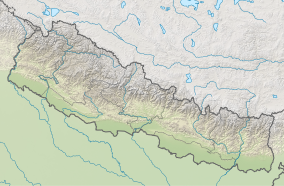बाँके नेशनल पार्क
बाँके नेशनल पार्क नेपाल के लुंबिनी प्रदेश में स्थित बा आ एकरा के "पृथ्वी के उपहार" के रूप में मान्यता मिलला के बाद 2010 में नेपाल के दसवाँ नेशनल पार्क के रूप में स्थापित कइल गइल।[1] संरक्षित इलाका 550 किमी2 (210 वर्ग मील) के क्षेत्रफल में बिस्तार लिहले बा आ ज्यादातर हिस्सा चुरिया पहाड़ी श्रेणी पर पड़े ला। ई पार्क बाँके, सल्यान आ डांग जिला सभ में 344 किमी2 (133 वर्ग मील) के बफर जोन से घेरल बा।[2]
| Banke National Park | |
|---|---|
आइयूसीएन श्रेणी II (राष्ट्रीय पार्क) | |
 Location in Nepal | |
| लोकेशन | नेपाल |
| नजदीकी शहर | कोहालपुर |
| भूगोलीय निर्देशांक | 28°11′28″N 81°54′46″E / 28.1911°N 81.9128°Eनिर्देशांक: 28°11′28″N 81°54′46″E / 28.1911°N 81.9128°E |
| रकबा | 550 km²[1] |
| स्थापना | 12 जुलाई 2010[1] |
| गवर्निग बॉडी | Department of National Parks and Wildlife Conservation |
पड़ोसी बर्दिया नेशनल पार्क के साथ मिल के 1,518 किमी2 (586 वर्ग मील) के सुसंगत संरक्षित क्षेत्र बाघ संरक्षण इकाई (TCU) बरदिया-बांके के प्रतिनिधित्व करे ला।[3]
वनस्पति
संपादन करींबांके नेशनल पार्क में बनल वनस्पति सभ में कम से कम 113 गो पेड़ प्रजाति, 107 गो जड़ी-बूटी प्रजाति आ 85 गो झाड़ी आ पर्वतारोही प्रजाति सभ के सामिल कइल गइल बा। आम प्रजाति सभ में साल, एक्सलवुड, सेमेकार्पस एनाकार्डियम, खैर, टर्मिनेलिया अलाटा सामिल बाड़ें।[4]
जियाजंतु
संपादन करींसंरक्षित इलाका में बाघ आ चार सींग वाला एंटीलोप बाड़ें।[5] साल 2014 में संरक्षित इलाका में पहिली बेर रूडी मैंगूज (नेउर के एगो प्रजाति) के रिकार्ड कइल गइल।[6]
इहो देखल जाय
संपादन करींसंदर्भ
संपादन करीं- ↑ 1.0 1.1 1.2 DNPWC (2010). Banke National Park Archived 2012-02-15 at the Wayback Machine Government of Nepal, Ministry of Forests and Soil Conservation, Department of National Parks and Soil Conservation
- ↑ Bhushal, R.P. (2010). Nod to Banke National Park. Archived 2014-12-18 at the Wayback Machine The Himalayan Times, 13 May 2010
- ↑ Wikramanayake, E.D., Dinerstein, E., Robinson, J.G., Karanth, K.U., Rabinowitz, A., Olson, D., Mathew, T., Hedao, P., Connor, M., Hemley, G., Bolze, D. (1999). Where can tigers live in the future? A framework for identifying high-priority areas for the conservation of tigers in the wild. Archived 2012-03-10 at the Wayback Machine Pages 255–272 in: Seidensticker, J., Christie, S., Jackson, P. (eds.) Riding the Tiger. Tiger conservation in human-dominated landscapes. Cambridge University Press, Cambridge. hardback ISBN 0-521-64057-1, paperback ISBN 0-521-64835-1.
- ↑ Napit, R. (2016). Species Diversity, Forest Community Structure and Regeneration in Banke National Park. Nepal Journal of Science and Technology 16(1): 17–30.
- ↑ Dhakal, M., Karki (Thapa), M., Jnawali, S. R., Subedi, N., Pradhan, N. M. B., Malla, S., Lamichhane, B. R., Pokheral, C. P., Thapa, G. J., Oglethorpe, J., Subba, S. A., Bajracharya, P. R. & Yadav, H. 2014. Status of Tigers and prey in Nepal. Department of National Parks.
- ↑ Subba, S.A., Malla, S., Dhakal, M., Thapa, B.B., Bahadur, L., Bhandari, K.O. and Bajracharya, P. (2014). Ruddy Mongoose Herpestes smithii: a new species for Nepal. Small Carnivore Conservation 51: 88–89.
